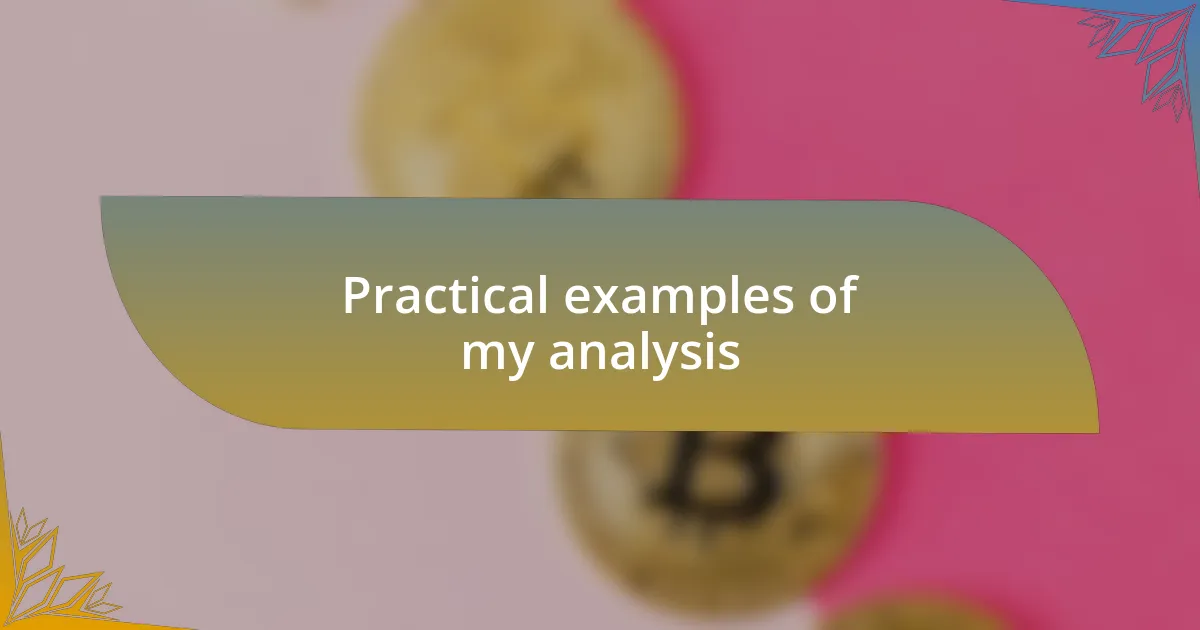Key takeaways:
- Technical analysis tools, like Moving Averages and RSI, help clarify market trends and investor psychology.
- Identifying candlestick patterns and Fibonacci retracement levels can signal potential market reversals and support/resistance points.
- Patience and following a trading plan are crucial for successful trading, reducing impulsive decisions.
- Continuous learning and adapting to market changes enhance trading skills and overall experience.

Understanding technical analysis tools
Technical analysis tools serve as a vital compass in navigating the volatile world of cryptocurrency. I remember my initial experiences using these tools – staring at charts full of numbers and being overwhelmed. What I learned is that these tools can turn that initial confusion into clarity, helping me make more informed decisions over time.
Indicators like Moving Averages or the Relative Strength Index (RSI) have become like trusted friends in my trading journey. When I analyze a coin’s performance through these lenses, I often ask myself whether the trends reveal anything unexpected. For instance, when I noticed a consistent pattern in the RSI indicating an overbought condition, I felt a rush of excitement; it felt like I had unlocked a secret about market behavior.
Using technical analysis is more than just crunching numbers; it’s about understanding market psychology. I find myself often pondering how a sudden spike in price might reflect collective investor emotion. Isn’t it fascinating how fear and greed can manifest so visibly in charts? This emotional insight has helped me pause and consider my strategy before jumping into trades, allowing room for reflection amidst the chaos.

Practical examples of my analysis
When I analyze a cryptocurrency’s movements, I often focus on candlestick patterns. I recall a time when I spotted a bullish engulfing pattern on the Ethereum chart. It’s that moment when a smaller bearish candle is completely swallowed by a larger bullish one. Seeing this pattern made me optimistic about the potential for a price reversal, and I decided to enter a position. That rush of anticipation—could I be catching the bottom of a downtrend?—is part of what makes trading so exhilarating.
I also use Fibonacci retracement levels to identify potential support and resistance points. On one occasion, after a sharp dive in Bitcoin’s price, I applied these levels and noticed how the price bounced right off the 61.8% retracement. The feeling of confirmation was powerful. It reinforced my belief that there’s a mathematical elegance to market movements, making me consider: how often do traders unknowingly follow these invisible lines that are grounded in math?
Another tool I find invaluable is volume analysis. I remember analyzing a lesser-known altcoin and noticed a significant spike in volume during a price surge. That surge brought back memories of past trades where high volume often indicated strong conviction behind the movement. It left me asking myself, am I ready to ride this wave or watch from the sidelines? This ongoing dialogue with myself about volume trends has sharpened my instincts and helped me connect more deeply with the market’s pulse.

Lessons learned from my experiences
Throughout my journey in technical analysis, I’ve learned that patience is a trader’s best ally. I remember a particular time when I entered a trade way too early, driven by FOMO—the fear of missing out. I quickly learned that the market often rewards those who wait for the right signals, rather than those who chase every fleeting opportunity. It’s a lesson that still resonates with me today: sometimes, standing still can lead to the biggest gains.
Another critical insight I’ve gained is the importance of sticking to a trading plan. There was a point where I let my emotions dictate my trades, leading to impulsive decisions and avoidable losses. One evening, after a disappointing day, I reflected on my strategy. It was a wake-up call! From that moment on, I committed to not only developing a solid plan but to executing it with discipline. In trading, consistency is the secret sauce to success.
Finally, I’ve come to understand the value of ongoing education. There was a time when I felt I had learned all I needed, only to realize how much the landscape can change. Every chart I analyze teaches me something new. I often ask myself: how can I further enhance my skills? This mindset of constant growth has not only improved my trading outcomes but has also made the entire experience more rewarding. Embracing the journey rather than fixating solely on the results has changed everything for me.